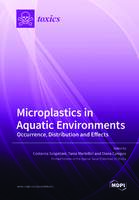Dublin Core
Title
Microplastics in Aquatic Environments
Subject
source; fate; bacterial degradation; marine environment; microplastics; microplastic pollutant; polystyrene; biodegradation; microalgae; per- and polyfluoroalkyl substances; microplastics; Muskegon Lake; plastics; riverine; coastal; estuary; characteristics; pollution; microplastics; population growth rate; polystyrene; polyamide; silica beads; fitness response; rotifers; Brachionus fernandoi; Brachionus calyciflorus; egg ratio; polystyrene microplastics; size-dependent uptake; vectors; cadmium; benzo(a)pyrene; mussels; invasive macroalgae; bivalves; marine debris; oxidative stress; energy balance; byssus production; microplastic; grass carp; size; accumulation; re-consumption; microplastic; shape; colour; polymer type; blackfly larvae; freshwaters; Simuliidae; microplastics; additives; plasticizers; microplastics; fibers; cellulose; Mediterranean Sea; pollution; chemical characterization; environmental pollution; biota contamination; n/a
Description
The large production and widespread daily consumption of plastic materials which began in the last century, together with the often inadequate collection and recycling systems, have made plastics and, consequently, microplastics (MPs) ubiquitous pollutants. Microplastic pollution as a global concern is confirmed by the research papers collected in this Special Issue; these papers come from 28 Universities and research institutions and are spread across ten countries on three continents. This Special Issue collected and published 11 novel contributions focusing on microplastics in aquatic environments, their occurrence and distribution, and the effects they might have on the environment and biota. As Guest Editors of this Special Issue, we were pleased to receive several papers concerning the interaction between microplastics and biota; despite a large number of peer-reviewed papers published on this research topic, there are still several gaps that need to be filled and there is concrete evidence suggesting that microplastic pollution may constitute a serious hazard to aquatic biota. The results of the contributions collected herein have helped to fill some knowledge gaps about the occurrence, distribution, and effects of microplastics on aquatic ecosystems. The outcomes clearly indicate that microplastic pollution is a serious environmental issue; the scientific community should increase its knowledge and understanding of how it could affect the environment, biota, and humans, and how it could be reduced and prevented.
Creator
Costanza Scopetani
Tania Martellini
Diana Campos
Tania Martellini
Diana Campos
Source
https://www.mdpi.com/books/reprint/6062-microplastics-in-aquatic-environments
Publisher
MDPI - Multidisciplinary Digital Publishing Institute
Date
2022
Contributor
Jadik Wijayanto
Rights
© by the authors
Relation
https://mdpi-res.com/bookfiles/book/6062/Microplastics_in_Aquatic_Environments.pdf?v=1708985086
Format
PDF
Language
English
Type
Textbooks
Identifier
ISBN : 978-3-0365-5047-3 (Hardback)
ISBN : 978-3-0365-5048-0 (PDF)
DOI : https://doi.org/10.3390/books978-3-0365-5048-0
ISBN : 978-3-0365-5048-0 (PDF)
DOI : https://doi.org/10.3390/books978-3-0365-5048-0
Coverage
Basel, Switzerland, 2022

